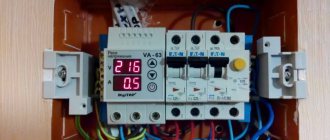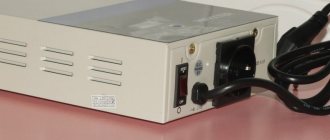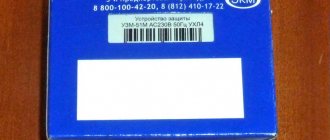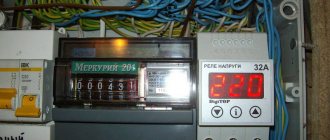The main purpose of the RCD is to disconnect the entire electrical network or its individual section from the power supply by opening the contacts. This ensures protection against electric shock and fire prevention. In modern electrical engineering, the use of these devices in many cases becomes mandatory, therefore, the question often arises of how to choose the right RCD. These protective devices are used not only in single-phase, but also in three-phase networks under various loads, therefore, their selection is made depending on the specific operating conditions.
Why do you need an RCD?
For an apartment, an RCD is installed to protect the electrical circuits of individual household appliances installed in wet areas of the apartment (house). For example, a washing machine in the bathroom. Also, RCDs are installed in multi-group electrical circuits for emergency shutdown of an entire group of consumers. For example, an RCD for the kitchen or children's room.
The second fundamental option, installing an RCD, is to protect the entire electrical circuit of the apartment, and more often the house, from fire.
RCDs for this purpose must have shutdown currents (cut-off currents) of more than 100 mA and have the letter S in the designation, which means delay (selectivity) of operation. It is impossible for the general RCD to turn off faster than the RCD of a separate group.
RCD automatic. Work and device. Connection and features
Plus, you need to add another protection device to the common input in the distribution board. This input device is connected with the condition that it will respond to a leakage current of 300 milliamps.
Expert opinion
It-Technology, Electrical power and electronics specialist
Ask questions to the “Specialist for modernization of energy generation systems”
How to choose an RCD in 5 minutes - Repair tips The operating current flows through the transformer and induces magnetic fluxes that have the opposite direction to each other and are the same in size, so the protection does not operate. Ask, I'm in touch!
Regulations
In these regulatory documents you will find information about RCDs for protecting people from leakage currents.
- PUE (Rules for Electrical Installations) ed.7
- SP 31-110-2003, Design and installation of electrical installations
- GOST R 50571.8-94, ELECTRICAL INSTALLATIONS OF BUILDINGS, Part 4
- GOST R 50571.11-96, Electrical installations of buildings, Part 7, Requirements for special electrical installations.
Other articles in this section
- Automatic circuit breakers
- Types of power transmission line supports by material
- Types of supports by purpose
- Overhead power lines with SIP wires
- Wooden supports for overhead power lines
- Reinforced concrete power transmission line supports
- Reinforced concrete power transmission line supports
- Protection of humans from electric shock, direct and indirect contact
- How does a 380 Volt low voltage consumer receive electricity?
- Cable network wells installation stages
RCD parameters important for selection
As a consumer buying an RCD for an apartment or house, the following are important to you; let’s call them the consumer characteristics of the RCD.
Operating voltage. There are two options here, an RCD for a 220 V network or for a 380 V network. Everything is simple, for protection in the circuits of individual household appliances you need a 220 V RCD, for groups and a general RCD 220 V or 380 V is possible.
Operation current. The operation current is also the cut-off current, also known as the setting current, this is the main characteristic for an RCD. According to the nomenclature, RCDs are produced with cut-off currents: 6, 10, 30, 100,300,500 mA. Recommendations for choosing cut-off current are as follows:
- To protect circuits of individual household appliances and electrical wiring groups, you need to select a 30 mA RCD.
- For improved protection in the circuits of individual household appliances and groups of electrical wiring, you need to select a 10 mA RCD. For example, an RCD for a bathroom (wet area) or an RCD for a children's room.
The following is important here. Installing a 10 mA RCD can lead to so-called false alarms of the RCD. That is, the RCD can disconnect the circuit without emergency situations. This is caused by the presence of natural (permissible) leakage currents in household appliances, as well as by the characteristics of specific electrical wiring.
Selecting the type of RCD
For household electrical circuits, there are two types of devices of interest: AC and A.
Type AC (“sees” only alternating current) is selected for general protection with installation for the entire electrical circuit. This type of RCD does not respond to pulsating currents and some individual household appliances with electronic control (pulsating current) will not be able to protect.
Type A (“sees” alternating and pulsating current), work great for protecting any single household appliances, for example, a washing machine.
RCD type S , has a response delay and is placed at the entrance to a house or apartment. This delay effect allows the RCD installed on individual groups to trip first.
What kind of lighting do you prefer?
Built-in Chandelier
Leakage current shape
According to this parameter, all residual current devices are classified into three types:
A completely logical question arises: in household networks, alternating current of a sinusoidal shape flows; can it be sufficient to install “AC” type devices everywhere? But if you take a closer look at the characteristics of modern household appliances, most of them have power supplies with electronic semiconductor components, reaching which the sine wave is converted into pulsed half-cycles. And if the leak is not of a sinusoidal nature, then the AC type RCD will not detect it and will not turn off.
That is why in the passports for many household appliances the manufacturer indicates through which RCD the connection must be made.
Tips for choosing an RCD on video:
Home circuit breaker device
- A toroidal core made from a specific grade of ferrite.
- Two primary coils (in a single-phase RCD), made of copper wire with a cross-section not lower than the rated load current.
- One secondary coil of thinner wire with more turns.
- An actuator designed to disconnect power contacts in the event of a current leak to the ground.
- A test button with resistance, necessary to check the RCD for operability, when pressed, the currents in the phase and neutral coils change, which leads to the tripping mechanism, the current amplifier (in an RCD with electronic control).
- Device body.
Operating principle of RCD without grounding
By and large, it does not need a grounding conductor to operate, since a phase and a working zero are used. These two conductors pass through a kind of current transformer with a control winding.
These tiny changes are recorded by the control coil and transmitted to the relay, which in turn activates the release mechanism and disconnects the line from the power supply.
Expert opinion
It-Technology, Electrical power and electronics specialist
Ask questions to the “Specialist for modernization of energy generation systems”
How does an RCD differ from a machine: main features, installation and connection Provides protection against leakage on both alternating and pulsed current modern TVs, power supplies, computers, etc. Ask, I’m in touch!
Purpose
The most important thing to understand is that a circuit breaker protects the electrical network from overcurrents, and an RCD provides human protection. If, as a result of an insulation breakdown, potential appears on the body of an electrical appliance, touching it is likely to result in an electric shock. To prevent this from happening, immediately when a current leak occurs, the protective shutdown device will react and turn off the damaged section of the circuit.
It is important to know! The RCD does not protect against overloads and short circuits, therefore, circuit breakers must be connected in series with them in the circuit
What type of RCD is applicable in houses and apartments
In addition to ground leakage shutdown, such circuit breakers provide protection against short circuits and overcurrent consumption. And your safety comes first!
Calculation of differential protection circuit breaker
The first step is to calculate the maximum current that electrical equipment in a house or apartment can consume. We calculate their total power in watts, which is indicated on the device nameplates, then divide the power by the network voltage, and get the current in amperes.
For example: the total power of the devices is 4000 watts. Divide by 220 volts and we get 18 amperes. Therefore, the circuit breaker must be at least 20 amperes.
As for the leakage current, 30 milliamps is suitable for an ordinary apartment. These are most often found in electrical goods stores.
If there is a shower stall for especially damp rooms, then it is advisable to make a separate power supply line and install a 10 milliampere automatic circuit breaker for greater safety.
Current rating of incoming circuit breakers operating in tandem with an RCD
The current rating of machines connected with an RCD in the panel, both input and in groups, must be lower than machines with differential protection. This is necessary so that the load in the network falls on conventional circuit breakers, since they cost ten times less than machines with RCDs.
Also, increased currents can cause incorrect operation of the RCD mechanism.
Installation errors
A common mistake when connecting an RCD in an apartment is that in sockets with grounding, the neutral wire, which does not pass through the RCD and is used as grounding, is connected to the neutral terminal in the socket. This causes the residual current circuit breaker to trip when you try to plug something into that outlet.
- If this happens, swap the neutral wire at the ground terminal of the knockout socket.
- You should also connect the wires at the input to the device correctly. The phase one is on the “L” contact, and the zero one is on the “N” contact. This will ensure the device operates correctly.
How to check the RCD for functionality
As already mentioned, there is a “test” button for this purpose.
But its operation does not guarantee complete protection. To fully verify the functionality of the device, it is necessary to simulate a leak to the ground once a month. This can be done very simply:
- Take a two-pole LED voltage indicator of the “contact” type.
- Determine the location of the phase in the socket.
- Insert one contact of the indicator into the phase, and the other will touch a grounded conductor, for example, a heating radiator or metal water pipes. Also, if it is in a country house or in a private house, simply stick the pin into the ground and touch it with the other end of the pointer.
How to choose the right one
To choose an RCD for an apartment, cottage or country house, you must first decide on the level of security that you plan to achieve.
The first thing to consider is the type of wiring. If the wiring is old, then installing a current differential switch is pointless: it will almost certainly contain leakage currents. If you select and install an RCD with a limit of 30 mA, it will trip too often.
If you install a device with a higher shutdown threshold, then it will have no practical meaning.
In addition, many brands of VDTs are not designed to work with aluminum wiring, which was the standard for apartments in houses built in the USSR.
Tags: machine, ampere, boiler, sconce, input, input machine, type, harm, choice, switch, extinguish, house, , protective, insulation, like, computer, , power, load, voltage, nominal, lighting, skew, variable, connection, potential, rule, touch, principle, wire, manufacturer, start, , work, row, garden, network, resistance, circuit, ten, type, current, three-phase, , installation, photo, panel, electrical panel, effect










